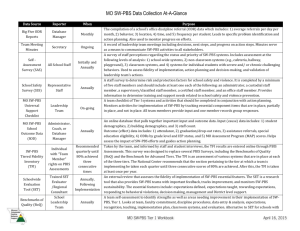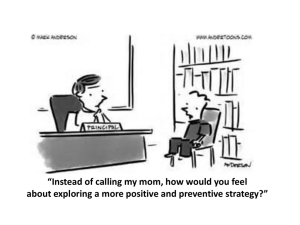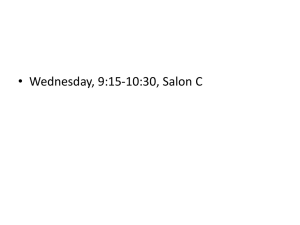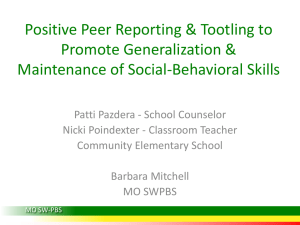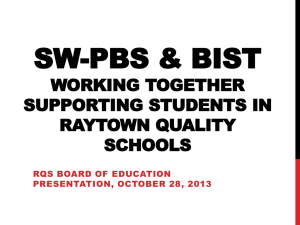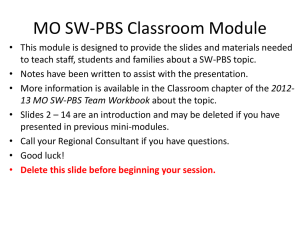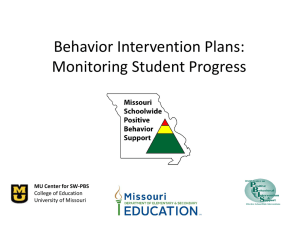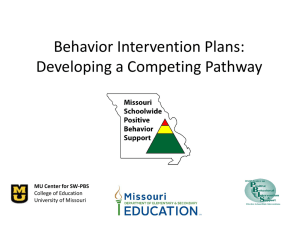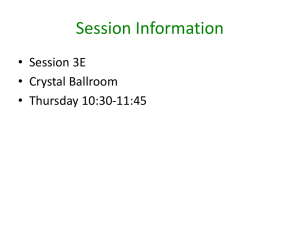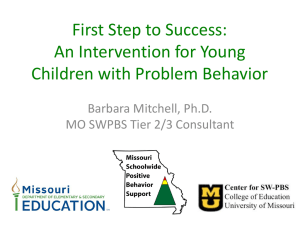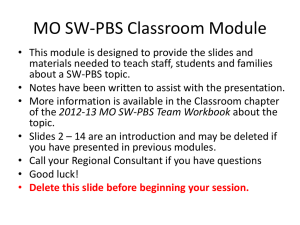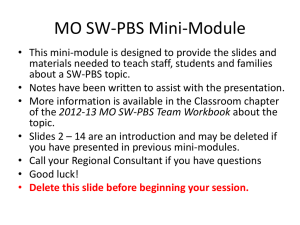Effective Classroom Practices - Missouri Schoolwide Positive
advertisement
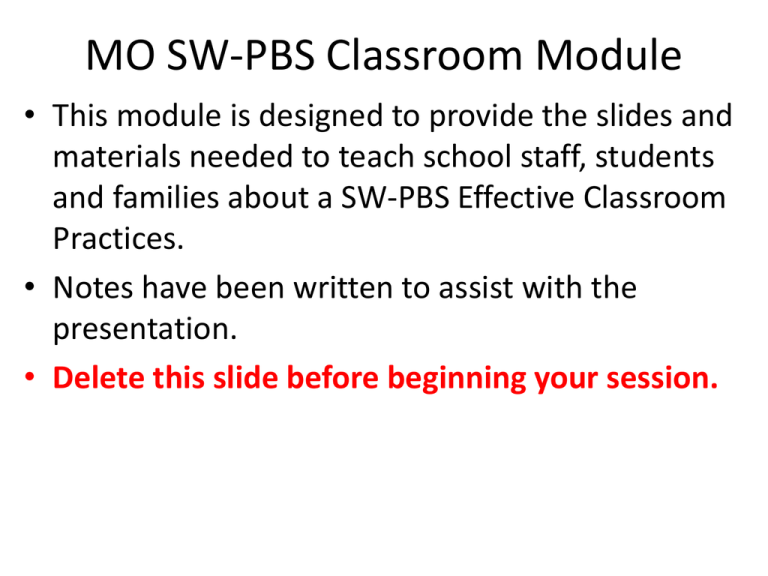
MO SW-PBS Classroom Module • This module is designed to provide the slides and materials needed to teach school staff, students and families about a SW-PBS Effective Classroom Practices. • Notes have been written to assist with the presentation. • Delete this slide before beginning your session. MO SW-PBS Classroom Module • More information is available in the Classroom chapter of the May 2014 MO SW-PBS Team Workbook. Specific information is noted by a page number on the bottom right of a slide. • There are no handouts for this overview. • An Introduction to Effective Classroom Practices video is also available at: http://vimeo.com/79681916 • Call your Regional Consultant if you have questions. • Good luck! • Delete this slide before beginning your session. MO SW-PBS Classroom Module • The notes on Slide 13, the list of Effective Classroom Practices, are based on a school that has already addressed the first four effective classroom practices in non-classroom settings such as the hallway, cafeteria, etc. Edit the notes to be relevant to what your school has implemented at this point in time. • Delete this slide before beginning your session. An Overview: Effective Classroom Practices MO SW-PBS Outcomes At the end of the session, you will be able to… • Explain to others the power of positive and proactive strategies in establishing an effective classroom learning environment. • Describe the eight Effective Classroom Practices. MO SW-PBS “When teachers know and use positive and preventative management strategies, many of the commonly reported minor classroom behaviors can be avoided.” Scheuermann & Hall, 2008 “Effective classroom management is a key component of effective instruction, regardless of grade level, subject, pedagogy or curriculum.” Sprick, Knight, Reinke & McKale, 2006 MO SW-PBS Three Levels of Implementation A Continuum of Support for All Academic Systems Behavioral Systems Tier Three Tier Three • Individual Students • Assessment-based • High Intensity • Individual Students • Assessment-based • Intense, durable procedures Tier Two • Some students (at-risk) • High efficiency • Rapid response Tier Two • Some students (at-risk) • High efficiency • Rapid response Tier One Tier One • All students • Preventive, proactive • All settings, all students • Preventive, proactive Typical School Day 17% 33% 20% 30% Direct Instruction Seatwork Transitions Discipline & Other Non-Instructional Activities Reinke, Herman & Stormont, 2013; Walberg, 1988 MO SW-PBS 328 Academic Learning Time There is no doubt academic learning time–the amount of time that students are actively, successfully, and productively engaged in learning–is a strong determinant of achievement. MO SW-PBS Academic Learning Time Instructional Time–the amount of the allocated time that actually results in teaching. Engaged Time–the amount of instructional time students are actively engaged in learning. MO SW-PBS Academic Learning Time Instructional Time–diminished by unclear procedures, disruptive student behavior, disciplinary responses, lengthy transitions, etc. Effective Classroom Practices to Increase Instructional Time: – Classroom Expectations – Classroom Procedures & Routines – Encouraging Expected Behavior – Discouraging Inappropriate Behavior MO SW-PBS Academic Learning Time Engaged Time–diminished by inactive supervision, limited opportunities for students to respond, poor task selection, etc. Effective Classroom Practices to Increase Time of Student Engagement: – Active Supervision – Opportunities to Respond – Activity Sequencing & Choice – Task Difficulty MO SW-PBS Effective Classroom Practices 1. 2. 3. 4. 5. 6. 7. 8. Classroom Expectations Classroom Procedures & Routines Encouraging Expected Behavior Discouraging Inappropriate Behavior Active Supervision Opportunities to Respond Activity Sequencing & Choice Task Difficulty MO SW-PBS 328 Think, Pair, Share Think to Yourself: When do I lose Instructional Time?When do I lose Engaged Time? Pair with a partner. Share your thinking. MO SW-PBS 328 Outcomes At the end of the session, you will be able to… Explain to others the power of positive and proactive strategies in establishing an effective classroom learning environment. • Describe the eight Effective Classroom Practices. MO SW-PBS Effective Positive Classroom Environments “The goal of effective classroom management is not creating “perfect” children, but providing the perfect environment for enhancing their growth, using researchbased strategies that guide students toward increasingly responsible and motivated behavior.” (Sprick, Knight, Reinke & McKale, 2006, p. 185) MO SW-PBS 1. Classroom Expectations 1. Develop a few behaviors/rules aligned with each schoolwide expectation (Example: Be Respectful—Follow Directions) 2. Post Expectations & Rules in prominent place and refer to them frequently 3. Teach rules explicitly 4. Recognize students when they follow rules MO SW-PBS 328 2. Classroom Procedures 1. Develop explicit steps to follow for common classroom activities (e.g. handing in papers) 2. Post classroom procedures in a prominent place and refer to them frequently 3. Teach classroom procedures explicitly 4. Recognize students when they follow the procedures MO SW-PBS 328 3. Encouraging Expected Behavior 1. Provide high rates of responses to students who comply with classroom rules & procedures through: – Specific Positive Verbal Feedback – Nonverbal Recognition 2. Ideal rate of responses when students follow classroom rules & procedures is 4 to 1 response to correct students. MO SW-PBS 328 4. Discouraging Inappropriate Behavior 1. Use an instructional approach when students make social behavioral errors similar to when students make academic errors. – Use professional tone and demeanor – Correct errors by telling students what to do, using language of the classroom expectations and rules 2. Use a variety of response strategies (e.g. redirect, re-teach) MO SW-PBS 328 5. Active Supervision 1. Continually monitor students by scanning, moving and interacting frequently and strategically. 2. Design classroom floor plan and lessons to consider ease of movement, student groupings, activity levels, etc. 3. Provide positive contact, positive and corrective feedback while moving. MO SW-PBS 328 6. Opportunities to Respond 1. Design lessons to provide a variety of strategies to increase students opportunities to respond and there, increase engaged time. 2. Strategy examples: – – – – – Various strategies to track students being called on Choral responding Non-verbal responses (e.g. thumbs up) Response Cards Guided Notes MO SW-PBS 328 7. Sequencing and Choice 1. Design lessons and assignment to sequence tasks by intermingling easy/brief tasks among longer or more difficult tasks. 2. Design lessons and assignments to offer a variety of choice options, for example: – Give students choice of partners – Offer locations in classroom to do work – Offer a variety of ways students can demonstrate their knowledge MO SW-PBS 328 8. Task Difficulty 1. Set students up for success by ensuring instruction, independent work and reading assignments are at students’ academic level. 2. Design lessons and assignments to address a variety of assignment lengths, response modes and increased opportunities for instruction or practice. MO SW-PBS 328 The Science of Behavior A B Antecedent Behavior Conditions or circumstances that increase the probability of a behavior occurring. An observable act. What the student does. The actions or reactions to the antecedents. Example: Hallway rules and procedures are established and taught. MO SW-PBS Example: Student keeps voice quiet, body to self, and walks on the right. C Consequence The resulting event or outcome that occurs immediately following the behavior. Impacts future occurrence of the behavior. Example: Teacher gives specific verbal recognition. Appropriate hall behavior increases. 22 The Science of Behavior A B Antecedent Behavior Conditions or circumstances that increase the probability of a behavior occurring. An observable act. What the student does. The actions or reactions to the antecedents. • Teach and practice • Student classroom expectations engagement • Use clear procedures and • Task completion routines • Expected classroom • Active supervision behaviors • Opportunities to respond • Provide choices C Consequence The resulting event or outcome that occurs immediately following the behavior. Impacts future occurrence of the behavior. High rates of specific positive feedback Discussion: Academic Learning Time Discuss with a partner: • What do we currently do to ensure uninterrupted learning time? • What do we currently do to ensure engaged time (e.g., practices to ensure that students are on task, responding frequently, and producing quality work matched to their ability)? MO SW-PBS 330 Effective classroom managers are known, not by what they do when misbehavior occurs, but by what they do to set their classroom up for academic success and to prevent problems from occurring. MO SW-PBS 328 Discussion: Implementation of Effective Classroom Practices 1. 2. 3. 4. 5. 6. 7. 8. Classroom Expectations Classroom Procedures & Routines Encouraging Expected Behavior Discouraging Inappropriate Behavior Active Supervision Opportunities to Respond Activity Sequencing & Choice Task Difficulty MO SW-PBS 328 References • Reinke, W.M., Herman, K.C., & Stormont, M. (2013). Classroom-level positive behavior supports in schools implementing SW-PBIS: Identifying areas for enhancement. Journal of Positive Behavior Interventions, 15(1), 39-50. • Scheuermann, B. K. and Hall, J. A. (2008). Positive behavioral supports for the classroom. Upper Saddle River, NJ: Pearson Merrill Prentice Hall. • Sprick, R., Knight, J., Reinke, W. & McKale, T. (2006). Coaching classroom management: Strategies and tools for administrators and coaches. Eugene, OR: Pacific Northwest Publishing. • Walberg, H. (1988). Synthesis of research on time and learning. Educational Leadership 45(6), 76-85. Questions MO SW-PBS For Videotapes, Short Modules for Staff Training and Other Resources… • Missouri Schoolwide Positive Behavior Support website: http://pbismissouri.org/educators/effectiveclass-practice
